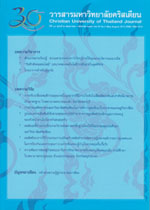ศักยภาพการเรียนรู้ : ความสามารถทางการเรียนรู้ภายใต้มุมมองนวัตกรรมแบบเปิด
บทคัดย่อ
บทความนี้นำเสนอการวิเคราะห์แนวคิดศักยภาพการเรียนรู้ โดยเสนอศักยภาพการเรียนรู้ว่าเป็นปัจจัยส่งผ่านสำคัญที่สร้างให้เกิดการเรียนรู้ของบุคลากรในองค์กร ซึ่งนำไปสู่การสร้างความสามารถในการสร้างนวัตกรรม การสร้างความได้เปรียบทางการแข่ง หรือสมรรถภาพขององค์กร การนำเสนอได้แบ่งออกเป็น 3 ส่วน ได้แก่ 1) รูปแบบแนวคิดศักยภาพการเรียนรู้ที่สำคัญ 2) ปัจจัยที่มาก่อนหน้าศักยภาพการเรียนรู้ปัจจัยแทรกซ้อนและผลลัพธ์ของศักยภาพการเรียนรู้ และ 3) ผลการทบทวนวรรณกรรมที่เกี่ยวข้องกับศักยภาพการเรียนรู้ การนำเสนอการวิเคราะห์แนวคิดศักยภาพการเรียนรู้นี้ทำให้เข้าใจได้อย่างถ่องแท้ในจุดเด่นจุดด้อยของแต่ละรูปแบบศักยภาพภาพการเรียนรู้ รวมไปถึงเข้าใจองค์ความรู้ที่มีอยู่และช่องว่างงานวิจัยที่เกี่ยวข้องกับแนวคิดศักยภาพการเรียนรู้
เอกสารอ้างอิง
Ahuja, G. (2000). “Collaboration networks, structural holes, and innovation : A longitudinal study”. Administrative Science Quarterly. 45(3) : 425-455.
Boud, D. (1985). Reflection : Turning experience into learning : Routledge.
Chaudhuri, S. & Tabrizi, B. (1999). “Capturing the real value in high-tech acquisitions”. Harvard Business Review. 77(5) : 123.
Chesbrough, H., Vanhaverbeke, W. & West, J. (2008). Open innovation : Researching a new paradigm : OUP Oxford.
Cohen, W. M., & Levinthal, D. A. (1989). “Innovation and learning: the two faces of R & D”. The Economic Journal. 99(397) : 569-596.
Cohen, W. M., & Levinthal, D. A. (1990). “Absorptive capacity : a new perspective on learning and innovation”. Administrative Science Quarterly. 35(1) : 128-152.
Deeds, D. L. (2001). “The role of R&D intensity, technical development and absorptive capacity in creating entrepreneurial wealth in high technology start-ups”. Journal of Engineering and Technology Management. 18(1) : 29-47.
Easterby-Smith, M. et al. (2008). “Absorptive capacity : A process perspective”. Management Learning. 39(5) : 483-501.
Garud, R., & Nayyar, P. R. (1994). “Transformative capacity : Continual structuring by intertemporal technology transfer”. Strategic Management Journal. 15(5) : 365-385.
Garvin, D. A. (1993). “Building a leaning organization”. Harvard Business Review, 73(4) : 78-91.
Granstrand, O., & Sjolander, S. (1990). “The acquisition of technology and small firms by large firms”. Journal of Economic Behavior & Organization. 13(3) : 367-386.
Gupta, A. K., & Govindarajan, V. (2000). “Knowledge flows within multinational corporations”. Strategic Management Journal. 21(4) : 473-496.
Huber, G. P. (1991). “Organizational learning : The contributing processes and the literatures”. Organization Science. 2(1) : 88-115
Kedia, B. L., & Bhagat, R. S. (1988). “Cultural constraints on transfer of technology across nations : Implications for research in international and comparative management”. Academy of Management Review. 13(4) : 559-571.
Kumar, S., & Seth, A. (2001). Knowledge, absorptive capacity, and the theory of the diversified firm. Academy of Management Proceedings BPS.
Lane, P. J., Koka, B. R., & Pathak, S. (2006). “The reification of absorptive capacity : a critical review and rejuvenation of the construct”. The Academy of Management Review ARCHIVE, 31(4) : 833-863.
Lewin, A. Y., & Volberda, H. W. (1999). “Prolegomena on coevolution : A framework for research on strategy and new organizational forms”. Organization Science. 10(5) : 519-534.
Nahapiet, J., & Ghoshal, S. (1998). “Social capital, intellectual capital, and the organizational advantage”. Academy of Management Review. 23(2) : 242-266.
Rossum, D. (2011). Recognizing : how small firms recognize external knowledge, 6-9.
Szulanski, G. (1996). “Exploring internal stickiness: Impediments to the transfer of best practice within the firm”. Strategic Management Journal. (17) : 27-43.
Todorova, G., & Durisin, B. (2007). “Absorptive capacity : valuing a reconceptualization”. The Academy of Management Review ARCHIVE. 32(3) : 774-786.
Tsai, W. (2001). “Knowledge transfer in intraorganizational networks : Effects of network position and absorptive capacity on business unit innovation and performance”. Academy of Management Journal, 44(5) : 996-1004.
Tsai, W., & Ghoshal, S. (1998). “Social capital and value creation : The role of intrafirm networks”. Academy of Management Journal. 41(4) : 464-476.
Van Den Bosch, F. A. J., Volberda, H. W., & De Boer, M. (1999). “Coevolution of firm absorptive capacity and knowledge environment : Organizational forms and combinative capabilities”. Organization Science. 10(5) : 551-568.
Volberda, H. W., Foss, N. J., & Lyles, M. A. (2010). “PERSPECTIVE---Absorbing the Concept of Absorptive Capacity : How to Realize Its Potential in the Organization Field”. Organization Science. 21(4) : 931-951.
Winter, S. G. (2003). “Understanding dynamic capabilities”. Strategic Management Journal. 24(10) : 991-995.
Zahra, S. A., & George, G. (2002). “Absorptive capacity: A review, reconceptualization, and extension”. Academy of Management Review, 27(2) : 185-203.



